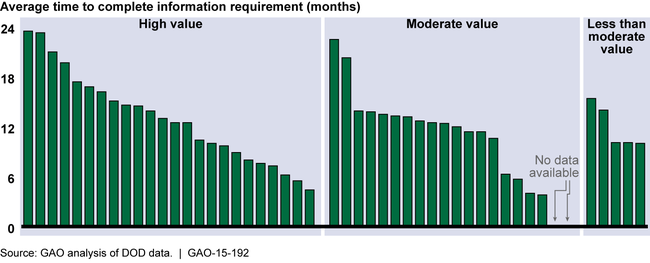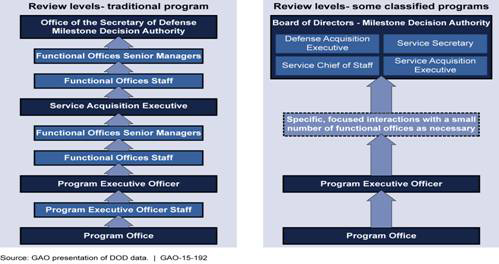Acquisition Reform: DOD Should Streamline Its Decision-Making Process for Weapon Systems to Reduce Inefficiencies
Highlights
What GAO Found
The acquisition programs GAO surveyed spent, on average, over 2 years completing numerous information requirements for their most recent milestone decision, yet acquisition officials considered only about half of the requirements as high value. The requirements, in total, averaged 5,600 staff days to document.
Average Time 24 DOD Programs Needed to Complete Information Requirements Grouped by the Value Acquisition Officials Considered Milestone B and C Requirements

The Department of Defense's (DOD) review process is a key factor that influences the time needed to complete information requirements. The process in some instances can include up to 56 organizations at 8 levels and accounts for about half of the time needed to complete information requirements. Most program managers felt that these reviews added high value to only 10 percent of the documents.
Comparison of Review Levels for DOD Traditional and Classified Programs

DOD's F-16 aircraft program, some classified programs, and five commercial firms GAO visited use streamlined processes with fewer documents and reviews and offer alternatives to the traditional DOD process. Establishing an efficient process for documentation and oversight is a key internal control to avoid wasteful spending. The challenge is to find the right balance between effective oversight and the competing demands on programs. DOD, however, has not yet identified ways to achieve the right balance by minimizing the time spent on information requirements and reviews that contribute to its inefficient milestone decision process.
Why GAO Did This Study
DOD has long sought to improve the efficiency of its weapon system acquisition process, including the time and effort needed to complete the milestone decision process.
The National Defense Authorization Act for Fiscal Year 2014 mandated GAO to review DOD's weapon system acquisition process. This report examines (1) the effort and value involved in the preparation for a milestone decision; (2) factors that influence the time needed to complete the milestone decision process; and (3) alternative processes used by some DOD programs and leading commercial firms.
To perform this work, GAO examined the levels of review and information requirements that are part of DOD's process. GAO surveyed 24 program managers and 40 other DOD officials on the value and the time to complete milestone documentation. For 15 program offices, we gathered data on the time to complete the entire milestone decision process. GAO discussed with DOD officials the factors that lead to inefficiencies. GAO also examined practices used by some classified DOD programs and five commercial firms generally recognized as leaders in product development.
Recommendations
GAO recommends that DOD identify and potentially eliminate reviews and information requirements that are no longer needed and select programs to pilot more streamlined approaches to provide only the most essential information to decision makers. DOD concurred with both recommendations.
Recommendations for Executive Action
| Agency Affected | Recommendation | Status |
|---|---|---|
| Department of Defense | To help improve DOD's milestone decision process, the Secretary of Defense should direct the Under Secretary of Defense for Acquisition, Technology and Logistics in collaboration with the military service acquisition executives, program executive officers, and program managers to, in the near term, identify and potentially eliminate (1) reviews associated with information requirements, with a specific focus on reducing review levels that do not add value, and (2) information requirements that do not add value and are no longer needed. For the remaining reviews and information requirements, evaluate and determine different approaches, such as consolidating information requirements and delegating approval authority, which could provide for a more efficient milestone process. This effort should also include a re-examination of the reason(s) why an information requirement was originally considered necessary in order to determine what information is still needed and if a more efficient approach could be used. Findings and survey responses included in this report could be used as a starting point for this examination. |
DOD has taken a number of steps to implement this recommendation. The Office of the Secretary of Defense (OSD) issued a policy directive called Better Buying Power 3.0 (BBP 3.0) in April 2015, which contains a section on streamlining documentation requirements and staff reviews. This was followed by the Office of the Under Secretary of Defense for Acquisition, Technology and Logistics issuing a memorandum that identified actions to be taken to address this BBP 3.0 section, including guidance and specific actions to streamline documentation requirements and staff reviews that are part of the defense acquisition system. The memorandum states that DOD officials are now expected to suggest options to condense the staffing review process, reduce the content of documents, or completely eliminate documents. In November 2015, the National Defense Authorization Act for Fiscal Year 2016 (P. L. 114-92) effectively reduced the number of review levels for major acquisition programs by changing the milestone decision authority for these program from OSD's Office of the Under Secretary of Defense for Acquisition, Technology and Logistics to the service acquisition executives of the military services. Further, all three military services have implemented, or are in the process of implementing actions to streamline information requirements in the defense acquisition system. The military services all now use an Electronic Coordination Tool to facilitate review, comment, and approval of documents within 14 days of receipt. The Air Force now provides specific direction to their acquisition programs to identify a particular strategy for streamlining documentation. In May 2017, the Air Force also issued a revised acquisition instruction, Air Force Instruction 63-101/20-101 Integrated Life Cycle Management, that minimizes or streamlines unique documentation, requirements, and processes. The Navy has received program documentation tailoring approval from OSD for several programs including the PA-8 Increment 3, Virginia Class Submarines, and the Littoral Combat Ship. In 2016, a comprehensive review by the Army identified 17 percent of Army-unique acquisition documentation requirements that could be eliminated. In June 2017 the Army revised its acquisition policy, AR 70-1, to reduce the scope and size of non-value added documentation and processes and reduce Army-unique requirements.
|
| Department of Defense | To help improve DOD's milestone decision process, the Secretary of Defense should direct the Under Secretary of Defense for Acquisition, Technology and Logistics in collaboration with the military service acquisition executives, program executive officers, and program managers to, as a longer-term effort, select several current or new major defense acquisition programs to pilot, on a broader scale, different approaches for streamlining the entire milestone decision process, with the results evaluated and reported for potential wider use. The pilot programs should consider the following: (1) Defining the appropriate information needed to support milestone decisions while still ensuring program accountability and oversight. The information should be based on the business case principles needed for well-informed milestone decisions including well defined requirements, reasonable life-cycle cost estimates, and a knowledge-based acquisition plan. (2) Developing an efficient process for providing this information to the milestone decision authority by (a) minimizing any reviews between the program office and the different functional staff offices within each chain of command level and (b) establishing frequent, regular interaction between the program office and milestone decision makers, in lieu of documentation reviews, to help expedite the process. |
DOD concurred with this recommendation, and as of February 2020 the Services had each identified one pilot program to implement streamlined acquisition processes. The Army chose the Improved Turbine Engine Program; the Navy chose the MQ-25 Stingray Unmanned Carrier Aviation Program; and the Air Force chose the MH-139 Grey Wolf Program. In August 2020, DOD identified specific acquisition streamlining initiatives (including ways to measure these initiatives) for these programs and informed Congress. GAO informally reviewed the list of initiatives and concluded they seem relevant and well- conceived. As of September 2022, these pilot projects and their associated initiatives are ongoing. While it will likely take several years to fully implement as these weapon system programs move through the acquisition phases, the steps the services took to start and sustain the pilots meet the intent of our recommendation.
|
